Understanding Blood Clots in the Legs: Causes, Symptoms, and Treatment

Blood clots in the legs, medically termed Deep Vein Thrombosis (DVT), represent a significant health issue that can lead to severe complications, including pulmonary embolism. Understanding how these clots form, recognizing their symptoms, and knowing how to treat and prevent them is crucial for maintaining vascular health and overall well-being.
What is a Blood Clot?
A blood clot is a gel-like mass formed by platelets and proteins in the blood. Clots play a vital role in healing wounds by preventing excessive bleeding; however, when they form inappropriately, they can obstruct blood flow, particularly in the legs. This obstruction can lead to serious health risks if not addressed promptly.
Types of Blood Clots
Blood clots can be categorized into two types:
- Thrombus: A clot that forms in a vessel and remains there.
- Embolus: A clot that has dislodged and travels through the bloodstream, which can lead to grave consequences when it lodges in vital organs.
Causes of Blood Clots in the Legs
Understanding the causes of blood clots in the legs is essential for prevention. Several factors can contribute to their formation:
- Prolonged Immobility: Sitting or lying down for extended periods, such as during a long flight or bed rest, can slow blood circulation.
- Injury: Damage to blood vessels can trigger clot formation as part of the healing process.
- Medical Conditions: Conditions such as cancer, heart disease, and clotting disorders can increase the risk.
- Hormonal Factors: Hormonal changes from pregnancy or hormone replacement therapy can contribute to higher clotting risk.
- Obesity: Excess body weight increases the pressure in the veins of the legs.
- Smoking: Tobacco use adversely affects circulation and increases the likelihood of clot formation.
Recognizing the Symptoms of Blood Clots in the Legs
Being able to recognize the symptoms of blood clots in the legs is crucial for seeking timely medical help. Symptoms may include:
- Swelling: Often occurs in one leg and may be accompanied by tenderness.
- Pain: A deep ache or cramping sensation in the calf or thigh.
- Change in Skin Color: The skin on the affected leg may appear red or bluish.
- Increased Warmth: The area around the clot may feel warmer to the touch than the surrounding skin.
If you experience these symptoms, especially following prolonged inactivity, it is essential to seek medical attention immediately.
Diagnosis of Blood Clots in the Legs
To diagnose blood clots in the legs, healthcare providers utilize several methods:
- Ultrasound: The most common diagnostic tool that uses sound waves to create images of blood flow in the veins.
- D-dimer Test: A blood test that measures the presence of a substance released when a blood clot breaks up.
- Venography: A less commonly used X-ray that requires a contrast dye to visualize the veins.
Treatment Options for Blood Clots in the Legs
Treatment for blood clots in the legs can vary based on the severity of the condition, but common approaches include:
- Anticoagulants: Medications such as warfarin or newer direct oral anticoagulants prevent existing clots from growing and new clots from forming.
- Thrombolytics: These are strong medications that dissolve clots and are typically used in more severe cases.
- Compression Stockings: Wearing compression garments can help reduce leg swelling and pain associated with DVT.
- Catheter-Directed Thrombectomy: A minimally invasive procedure that removes the clot using a catheter.
- Inferior Vena Cava (IVC) Filter: In certain cases, an IVC filter may be placed to prevent clots from reaching the lungs.
Preventative Measures for Blood Clots
Preventing blood clots in the legs is crucial, especially for individuals at high risk. Here are some effective strategies:
- Stay Active: Regular exercise enhances circulation and decreases the risk of clot formation.
- Leg Exercises: During long periods of immobility, perform leg exercises to stimulate blood flow.
- Manage Weight: Maintaining a healthy weight reduces pressure on the veins.
- Hydration: Staying well-hydrated can help maintain healthy blood viscosity.
- Avoid Smoking: Quitting smoking can significantly improve vascular health.
- Medical Management: If you have medical conditions that increase your risk, follow up with your healthcare provider for appropriate management.
Living with the Risk of Blood Clots
For individuals who have experienced blood clots in the legs or are at high risk, ongoing management is vital. Regular check-ups with a vascular specialist can guide the best course of action and ensure overall health. Lifestyle changes, medication adherence, and education about the signs of complications are all essential in managing this risk effectively.
Conclusion
Blood clots in the legs pose serious health risks but understanding their causes, symptoms, and treatments can empower individuals to take control of their vascular health. With appropriate measures, it is possible to mitigate the risk and lead a healthy, active life.
Consult with Experts at Truffles Vein Specialists
For tailored advice and comprehensive treatment options for blood clots in the legs, consult with the professionals at Truffles Vein Specialists. Our dedicated team of vascular medicine experts is here to support your journey towards better vascular health.
blood clots legs







